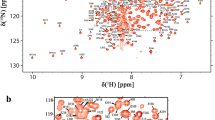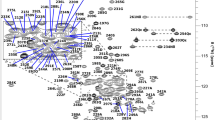Abstract
SAPK-interacting protein 1 (Sin1) is an important component of the target of rapamycin (TOR) complex 2 (TORC2). TOR is a serine/threonine-specific protein kinase and forms functionally distinct protein complexes referred to as TORC1 and TORC2. TORC2, conserved from yeast to humans, phosphorylates AGC-family protein kinases and has many cellular functions including the regulation of actin cytoskeleton. The Sin1 subunit of TORC2 is required for the binding of TORC2 to substrates, and the conserved region in the middle (CRIM) domain of Sin1 is important in the substrate recognition of TORC2. Here, we report on the 1H, 13C and 15N resonance assignments of fission yeast Schizosaccharomyces pombe Sin1 (amino acids 247–400) (Sin1CRIM), which possesses the CRIM domain. These data contribute toward the structure determination of Sin1CRIM and an understanding of the interactions of Sin1CRIM with substrates of TORC2.


Similar content being viewed by others
References
Berjanskii MV, Wishart DS (2005) A simple method to predict protein flexibility using secondary chemical shifts. J Am Chem Soc 127(43):14970–14971
Cameron AJ, Linch MD, Saurin AT, Escribano C, Parker PJ (2011) mTORC2 targets AGC kinases through Sin1-dependent recruitment. Biochem J 439(2):287–297
Cybulski N, Hall MN (2009) TOR complex 2: a signaling pathway of its own. Trends Biochem Sci 34(12):620–627
Delaglio F, Grzesiek S, Vuister G, Zhu G, Pfeifer J, Bax A (1995) NMRPipe: a multidimensional spectral processing system based on UNIX pipes. J Biomol NMR 6(3):277–293
Goddard TD, Kneller DG (2008) SPARKY 3. University of California, San Francisco
Hayashi K, Kojima C (2008) pCold-GST vector: a novel cold-shock vector containing GST tag for soluble protein production. Protein Expr Purif 62(1):120–127
Heitman J, Movva NR, Hall MN (1991) Targets for cell cycle arrest by the immunosuppressant rapamycin in yeast. Science 253(5022):905–909
Huang W, Zhu PJ, Zhang S, Zhou H, Stoica L, Galiano M, Krnjević K, Roman G, Costa-Mattioli M (2013) mTORC2 controls actin polymerization required for consolidation of long-term memory. Nat Neurosci 16(4):441–448
Ikeda K, Morigasaki S, Tatebe H, Tamanoi F, Shiozaki K (2008) Fission yeast TOR complex 2 activates the AGC-family Gad8 kinase essential for stress resistance and cell cycle control. Cell Cycle 7(3):358–364
Jacinto E, Lorberg A (2008) TOR regulation of AGC kinases in yeast and mammals. Biochem J 410(1):19–37
Jacinto E, Facchinetti V, Liu D, Soto N, Wei S, Jung SY, Huang Q, Qin J, Su B (2006) SIN1/MIP1 maintains rictor-mTOR complex integrity and regulates Akt phosphorylation and substrate specificity. Cell 127(1):125–137
Johnson B, Blevins R (1994) NMRView: a computer-program for the visualization and analysis of NMR data. J Biomol NMR 4(5):603–614
Kobayashi N, Iwahara J, Koshiba S, Tomizawa T, Tochio N, Güntert P, Kigawa T, Yokoyama S (2007) KUJIRA, a package of integrated modules for systematic and interactive analysis of NMR data directed to high-throughput NMR structure studies. J Biomol NMR 39(1):31–52
Lee S, Comer FI, Sasaki A, McLeod IX, Duong Y, Okumura K, Yates JR, Parent CA, Firtel RA (2005) TOR complex 2 integrates cell movement during chemotaxis and signal relay in Dictyostelium. Mol Biol Cell 16(10):4572–4583
Pan D, Matsuura Y (2012) Structures of the pleckstrin homology domain of Saccharomyces cerevisiae Avo1 and its human orthologue Sin1, an essential subunit of TOR complex 2. Acta Crystallogr Sect F Struct Biol Cryst Commun 68(Pt 4):386–392
Rovnyak D, Frueh DP, Sastry M, Sun ZY, Stern AS, Hoch JC, Wagner G (2004) Accelerated acquisition of high resolution triple-resonance spectra using non-uniform sampling and maximum entropy reconstruction. J Magn Reson 170(1):15–21
Sarbassov DD, Guertin DA, Ali SM, Sabatini DM (2005) Phosphorylation and regulation of Akt/PKB by the rictor-mTOR complex. Science 307(5712):1098–1101
Schmidt A, Kunz J, Hall MN (1996) TOR2 is required for organization of the actin cytoskeleton in yeast. Proc Natl Acad Sci USA 93(24):13780–13785
Schroder W, Cloonan N, Bushell G, Sculley T (2004) Alternative polyadenylation and splicing of mRNAs transcribed from the human Sin1 gene. Gene 339:17–23
Schroder WA, Buck M, Cloonan N, Hancock JF, Suhrbier A, Sculley T, Bushell G (2007) Human Sin1 contains Ras-binding and pleckstrin homology domains and suppresses Ras signalling. Cell Signal 19(6):1279–1289
Shen Y, Delaglio F, Cornilescu G, Bax A (2009) TALOS+: a hybrid method for predicting protein backbone torsion angles from NMR chemical shifts. J Biomol NMR 44(4):213–223
Wullschleger S, Loewith R, Hall MN (2006) TOR signaling in growth and metabolism. Cell 124(3):471–484
Yang Q, Inoki K, Ikenoue T, Guan KL (2006) Identification of Sin1 as an essential TORC2 component required for complex formation and kinase activity. Genes Dev 20(20):2820–2832
Acknowledgments
We thank Yuki Nishigaya for the mass spectrometry, and Izuru Ohki, Shinichi Murayama and Hisashi Tatebe for helpful comments. This work was supported in part by grants from MEXT/JSPS KAKENHI, TPRP, Platform for Drug Discovery, Informatics, and Structural Life Science to K.S., T.F. and C.K., and Grants-in-Aid for JSPS Fellows to S.K. and K.F.
Author information
Authors and Affiliations
Corresponding authors
Rights and permissions
About this article
Cite this article
Kataoka, S., Furuita, K., Hattori, Y. et al. 1H, 15N and 13C resonance assignments of the conserved region in the middle domain of S. pombe Sin1 protein. Biomol NMR Assign 9, 89–92 (2015). https://doi.org/10.1007/s12104-014-9550-6
Received:
Accepted:
Published:
Issue Date:
DOI: https://doi.org/10.1007/s12104-014-9550-6




